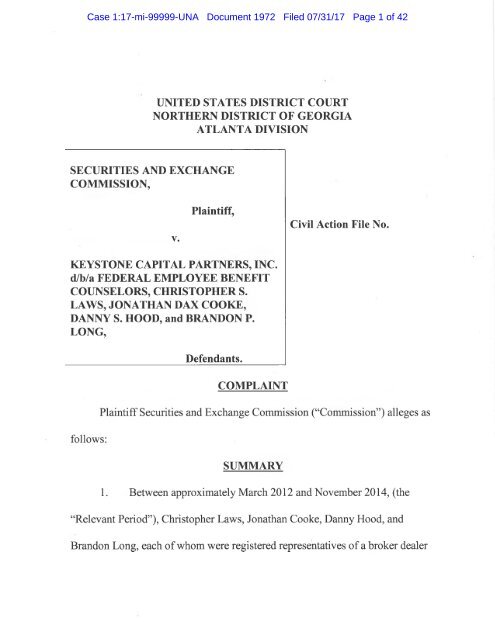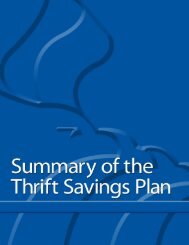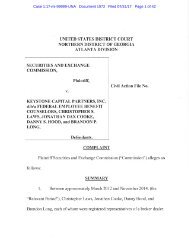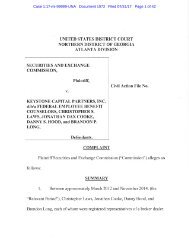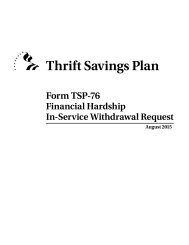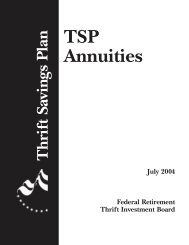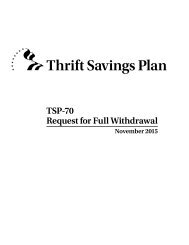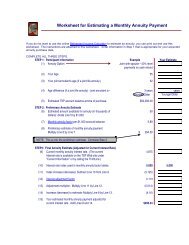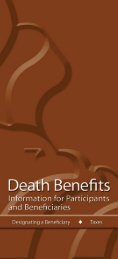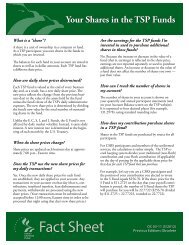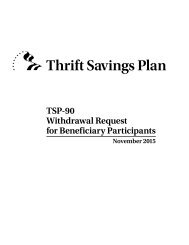Federal Employee Benefits Counselors
You also want an ePaper? Increase the reach of your titles
YUMPU automatically turns print PDFs into web optimized ePapers that Google loves.
Case 1:17-mi-99999-UNA Document 1972 Filed 07/31/17 Page 1 of 42<br />
UNITED STATES DISTRICT COURT<br />
NORTHERN DISTRICT OF GEORGIA<br />
ATLANTA DIVISION<br />
SECURITIES AND EXCHANGE<br />
COMMISSION,<br />
v.<br />
Plaintiff,<br />
Civil Action File No.<br />
KEYSTONE CAPITAL PARTNERS, INC.<br />
dlb/a FEDERAL EMPLOYEE BENEFIT<br />
COUNSELORS, CHRISTOPHER S.<br />
LAWS, JONATHAN DAX COOKS,<br />
DANNY S. HOOD, and BRANDON P.<br />
LONG,<br />
follows:<br />
Defendants.<br />
COMPLAINT<br />
Plaintiff Securities and Exchange Commission ("Commission") alleges as<br />
SUMMARY<br />
1. Between approximately March 2012 and November 2014, (the<br />
"Relevant Period"), Christopher Laws, Jonathan Cooke, Danny Hood, and<br />
Brandon Long, each of whom were registered representatives of a broker dealer
Case 1:17-mi-99999-UNA Document 1972 Filed 07/31/17 Page 2 of 42<br />
(collectively, the "Representatives"), fraudulently induced federal employees to<br />
rollover significant funds from their federal retirement accounts, referred to as<br />
Thrift Savings Plan ("TSP") accounts, into variable annuity products promoted<br />
under the banner of an entity called Keystone Capital Partners, Inc. d/b/a <strong>Federal</strong><br />
<strong>Employee</strong> <strong>Benefits</strong> <strong>Counselors</strong>.<br />
2. Motivated by the prospect of high commissions associated with the<br />
variable annuities, the Representatives targeted federal employees, age 59 1/~ and<br />
over, who had significant TSP account holdings that could be rolled over on a<br />
tax-free basis into variable annuities held in qualified plans at annuity carriers.<br />
3. Defendants employed several tactics calculated to mislead federal<br />
employees into believing that Defendants and their recommended investment<br />
(that is, a variable annuity) were affiliated with or approved by the federal<br />
government. For example, despite the fact that their recommended investments<br />
had no connection to the TSP, the Representatives, in recommending this<br />
investment: (a) made misleading comparisons between their recommended<br />
investment and the life annuity offered through the TSP by omitting key<br />
information oi• falsely describing the actual fee structure and surrender fees<br />
related to their recommended investment; (b) used an eagle-encircled insignia on<br />
-2-
Case 1:17-mi-99999-UNA Document 1972 Filed 07/31/17 Page 3 of 42<br />
other documents given to customers and on their website that resembled the<br />
official seal of various agencies of the federal government; and (c) used a name,<br />
<strong>Federal</strong> <strong>Employee</strong> <strong>Benefits</strong> <strong>Counselors</strong>, that insinuated that they were affiliated<br />
with the federal government while obscuring the fact that they were associated<br />
with a broker dealer.<br />
4. Further adding to the false impression that their investment was<br />
affiliated with or approved by the TSP, the Representatives combined into one<br />
form the documents the Representative needed to purchase the variable annuity<br />
with the portions of the official TSP Form that was needed to transfer funds from<br />
the federal employees' TSP accounts, and referred to the variable annuity<br />
investment using terminology from an official TSP form.<br />
5. In truth, the variable annuities that Defendants offered and sold<br />
were privately-issued, separate and apart from the TSP and the federal<br />
government, and had much higher costs than alternatives available through the<br />
TSP. Moreover, the Representatives had no affiliation with, and were not<br />
approved or vetted by, the federal government.<br />
6. The promotional materials that Defendants gave to potential<br />
investors also touted the additional benefits of the investment option they<br />
-3-
Case 1:17-mi-99999-UNA Document 1972 Filed 07/31/17 Page 4 of 42<br />
recommended as compared to the life annuity offered through the TSP, without<br />
disclosing the significantly higher annual fees and surrender charges.<br />
7. During the Relevant Period, Defendants sold approximately 200<br />
variable annuities with a total face value of over approximately $40 million to<br />
federal employees, who used monies rolled over from their TSP accounts to fund<br />
their purchases, and the Representatives collectively earned approximately $1.7<br />
million in commissions on these sales.<br />
8. In connection with at least five of these sales, Defendants Hood and<br />
Long made additional oral misrepresentations or omissions further suggesting<br />
that the investment option they recommended was affiliated with the TSP, and<br />
misrepresented or omitted to disclose the associated fees.<br />
9. Further obscuring that Defendants and their recommended<br />
investments were unaffiliated with the TSP and the federal government, some of<br />
the Defendants also opened accounts with their broker dealer in these five<br />
investors' names without the investors' knowledge or consent.<br />
10. The broker dealer that employed the Representatives required that<br />
an account be opened in an investor's name before the Representatives could<br />
place a variable annuity order on the investor's behalf. But some of the investors
Case 1:17-mi-99999-UNA Document 1972 Filed 07/31/17 Page 5 of 42<br />
did not learn of the creation or existence of these accounts in their names until<br />
after their TSP accounts had been liquidated (that is, the underlying securities<br />
were sold) and the funds transferred to purchase the variable annuity.<br />
11. Defendants also did not give these five investors the prospectuses<br />
for those investments, even though this was required by the broker dealer that<br />
employed the Representatives. This also veiled the fact that the investment<br />
option they recommended to these investors was a variable annuity issued by a<br />
private insurance company that had no connection to, and had not been<br />
specifically approved or vetted by, the TSP or the federal government.<br />
JURISDICTION AND VENUE<br />
12. The Commission brings this action pursuant to the authority<br />
conferred upon it by Sections 20(b) and 20(d) of the Securities Act of 1933<br />
("Securities Act") [15 U.S.C. §§ 77t(b) and 77t(d)] and Section 21(d) of the<br />
Securities Exchange Act of 1934 ("Exchange Act") [15 U.S.C. § 78u(d)].<br />
13. This Court has jurisdiction over this action pursuant to Section<br />
22(a) of the Securities Act [15 U.S.C. § 77v(a)] and Section 27(a) of the<br />
Exchange Act [15 U.S.C. § 78aa(a)].<br />
-5-
Case 1:17-mi-99999-UNA Document 1972 Filed 07/31/17 Page 6 of 42<br />
14. In connection with the transactions, acts, practices, and courses of<br />
business described in this Complaint, Defendants, directly and indirectly, have<br />
made use of the means or instrumentalities of interstate commerce, of the mails,<br />
and/or of the means and instruments of transportation or communication in<br />
interstate commerce.<br />
15. Venue is proper in this district as all defendants reside in this<br />
district.<br />
FACTS<br />
A. Defendants<br />
16. <strong>Federal</strong> <strong>Employee</strong> Benefit <strong>Counselors</strong> ("FEBC") is a d/b/a of<br />
Keystone Capital Partners, Inc., which is aGeorgia-registered corporation<br />
that was cofounded by Christopher Laws and Jonathan Cooke in early 2012.<br />
From its inception until December 2014, FEBC's office was located in the<br />
same office in Alpharetta, Georgia as the Office of Supervisory Jurisdiction<br />
("OSJ") for the broker dealer with whom the Representatives were registered<br />
(the "Broker Dealer"). Christopher Laws was the manager of this office (the<br />
"Alpharetta OSJ").
Case 1:17-mi-99999-UNA Document 1972 Filed 07/31/17 Page 7 of 42<br />
17. Christopher S. Laws ("Laws"), age 49, lives in Alpharetta,<br />
Georgia. From July 2005 to December 2014, Laws was a registered<br />
representative with the Broker Dealer, and at least as early as 2006, he was the<br />
manager of the Broker Dealer's Alpharetta OSJ. Laws co-owns FEBC with<br />
Jonathan Cooke, and during the Relevant Period, was the entity's CFO and<br />
Secretary. In December 2014, Laws was terminated from the Broker Dealer.<br />
From that time until March 2017, Laws was a registered representative with<br />
another broker dealer. On or about March 31, 2017, Laws was permitted to<br />
resign from that broker dealer when that firm terminated its relationship with<br />
the branch office from which Laws had operated.<br />
18. Jonathan Dax Cooke ("Cooke"), age 34, lives in Atlanta,<br />
Georgia. From May 2009 to December 2014, Cooke was a registered<br />
representative with the Broker Dealer in the firm's Alpharetta OSJ. Cooke coowns<br />
FEBC with Laws, and, during the Relevant Period, was the entity's CEO.<br />
In December 2014, Cooke was terminated from the Broker Dealer. From that<br />
time until the voluntary termination of his registration in December 2016,<br />
Cooke was a registered representative with another broker dealer.<br />
-7-
Case 1:17-mi-99999-UNA Document 1972 Filed 07/31/17 Page 8 of 42<br />
19. Brandon Preston Long ("Long"), age 28, lives in Atlanta,<br />
Georgia. From Apri12014 to December 2014, Long was a registered<br />
representative with the Broker Dealer in that firm's Alpharetta OSJ. In<br />
December 2014, Long was terminated from the Broker Dealer. From that time<br />
until March 2017, Long was a registered representative with another broker<br />
dealer. On or about March 31, 2017, Long was permitted to resign from that<br />
broker dealer when that firm terminated its relationship with the branch office<br />
from which he had operated.<br />
20. Danny Scott Hood ("Hood"), age 44, lives in Marietta, Georgia.<br />
From October 2012 to December 2014, Hood was a registered representative<br />
with the Broker Dealer based in the firm's Alpharetta OSJ. In December 2014,<br />
Hood was terminated from the Broker Dealer. From December 2014 to August<br />
2015, Hood was a registered representative with two other brokerage firms, and<br />
with respect to one of those firms, was an investment adviser representative for<br />
the affiliated investment adviser. Since August 2015, Hood has been an<br />
investment adviser representative with an investment adviser that is registered<br />
with the Commission.
Case 1:17-mi-99999-UNA Document 1972 Filed 07/31/17 Page 9 of 42<br />
B. Other Relevant Entity<br />
21. The Broker Dealer is a California corporation headquartered in<br />
Boston, Massachusetts and is dually registered with the Commission as a<br />
broker-dealer and an investment adviser. During the Relevant Period, all of the<br />
variable annuity sales at issue were processed through the Broker Dealer's<br />
Alpharetta OSJ, of which Laws was the manager.<br />
C. FEBC's Origins and Treatment as an Outside Business Activity<br />
22. In early 2012, Laws and Cooke founded FEBC as a "doing<br />
business as" name for Keystone Capital Partners, Inc. As co-owners of FEBC,<br />
Laws served as FEBC's CFO and Secretary, and Cooke served as the<br />
company's CEO.<br />
23. During the Relevant Period, FEBC was based in the same<br />
location as the Broker Dealer's Alpharetta OSJ from which Laws (the OSJ<br />
manager), Cooke, Hood and Long conducted securities transactions as the<br />
Broker Dealer's registered representatives.<br />
24. Under the Broker Dealer's applicable policies, registered<br />
representatives were required to provide written notice to the Broker Dealer of<br />
any intended outside business activity ("OBA"), and they were required to
Case 1:17-mi-99999-UNA Document 1972 Filed 07/31/17 Page 10 of 42<br />
obtain written approval from the Broker Dealer before engaging in the<br />
proposed activity.<br />
25. In or around March 2012, Laws and Cooke disclosed FEBC to the<br />
Broker Dealer's Advisor Review Group as an OBA. In doing so, however,<br />
they falsely characterized FEBC as anon-securities related entity that sold only<br />
fixed or non-variable insurance products. The Broker Dealer's Advisor<br />
Review Group gave Laws and Cooke written approval to operate FEBC as a<br />
non-securities OBA that the firm had no obligation to supervise under FINRA<br />
Rule 3040 (current Rule 3280).<br />
D. Background on the TSP Program and Relevant Withdrawal Options<br />
26. The federal government offers its employees atax-deferred<br />
retirement savings account which is akin to a 401(k) program. That program is<br />
referred to as the Thrift Savings Plan or "TSP."<br />
27. Upon leaving federal service, federal employees have three<br />
options for making a full withdrawal of their entire TSP account, any two or<br />
three of which can be combined: (1) a single payment, (2) a series of monthly<br />
payments spread out over time, and (3) as a TSP life annuity, which the TSP<br />
purchases on behalf of the TSP participant from the TSP's annuity vendor. The<br />
-10-
Case 1:17-mi-99999-UNA Document 1972 Filed 07/31/17 Page 11 of 42<br />
TSP life annuity provides a monthly benefit paid to the employee for life and, if<br />
the employee chooses, for the life of a designated survivor.<br />
28. To purchase the life annuity, the former employee must complete a<br />
"Form TSP-70," as a request for a full withdrawal from the TSP, and select the<br />
"life annuity" option within the "Withdrawal Election" section of that form.<br />
29. Current federal employees age 59 '/z or older who are not planning<br />
an immediate separation from federal service have the option to take partial or<br />
full withdrawals from their TSP accounts. To effectuate such a withdrawal,<br />
which is referred to as an age-based, in-service withdrawal, the employee must<br />
complete a "Form TSP-75."<br />
E. The Broker Dealer's Required Procedures to Purchase a Variable<br />
Annui<br />
30. Before a registered representative of the Broker Dealer could sell a<br />
variable annuity through the Broker Dealer, the firm's Written Supervisory<br />
Procedures and Advisor Compliance Manual (collectively, "Compliance<br />
Procedures") required a retirement account to be opened in the customer's name<br />
at the Broker Dealer that would ultimately be linked to the variable annuity<br />
contract (sometimes called a "tracking account").<br />
-11-
Case 1:17-mi-99999-UNA Document 1972 Filed 07/31/17 Page 12 of 42<br />
31. The registered representative was required to open a tracking<br />
account in the Broker Dealer's new account system, which, in turn, required the<br />
registered representative to enter certain information about the proposed account<br />
holder, including the information requested in the Broker Dealer's "Account<br />
Application."<br />
32. After the tracking account was opened, the registered representative<br />
was then required to enter certain information concerning the variable annuity<br />
order into the Broker Dealer's Annuity Order Entry ("AOE") system, including<br />
the date on which the registered representative sent the variable annuity<br />
prospectus to the customer.<br />
33. During much of the Relevant Period, the AOE system generated<br />
related transaction forms that the variable annuity customer was required to sign,<br />
including afour-page form entitled, "Important Information Regarding Your<br />
Variable Annuity" (the "Variable Annuity Form").<br />
34. The variable annuity order was then to be submitted in the AOE<br />
system for a suitability review and approval by the OSJ manager or the<br />
manager's designated principal, and then submitted to the carrier. The carrier<br />
then issued the variable annuity contract and sent a bound copy to the registered<br />
-12-
Case 1:17-mi-99999-UNA Document 1972 Filed 07/31/17 Page 13 of 42<br />
representative with instructions that he or she deliver the contract to the<br />
customer.<br />
35. The registered representative was then required to obtain a signed<br />
delivery receipt from the customer, send the customer-signed receipt to the<br />
carrier, and preserve copies in the customer file at the Broker Dealer.<br />
F. The Fraudulent Scheme to Sell Variable Annuities<br />
1. Defendants Target <strong>Federal</strong> <strong>Employee</strong>s With Sizeable TSP Accounts<br />
for Variable Annuity Purchases<br />
36. Contrary to disclosures made to the Broker Dealer concerning the<br />
scope of FEBC's activities, Defendants sold approximately 200 variable<br />
annuities (with a total face value of over approximately $40 million) to<br />
approximately 200 FEBC-prospected federal employees who used funds from<br />
their TSP accounts to purchase these annuities.<br />
37. Hood and Long received commissions on each variable annuity they<br />
sold. Laws and Cooke received a share of the associated commissions earned on<br />
each variable annuity sold by Hood and Long.<br />
38, To identify prospective customers for the sale of variable annuity<br />
products, the Representatives and/or FEBC administrative staff acting at the<br />
-13-
Case 1:17-mi-99999-UNA Document 1972 Filed 07/31/17 Page 14 of 42<br />
direction of Laws and Cooke, used various Internet sources and subscribed to<br />
various proprietary databases to obtain personal information about federal<br />
employees.<br />
39. Through mailed surveys, FEBC employees scheduled and<br />
conducted initial "benefits review" sessions with federal employees, which<br />
involved a review of the federal employee's life, health, disability insurance<br />
plans, and, based on salary information provided by the federal employees, their<br />
projected payouts from the federal retirement system.<br />
40. Interested federal employees who were eligible to roll over TSP<br />
account funds to a qualified plan on a tax-free basis were referred to one of the<br />
Representatives for "TSP counseling" services.<br />
41. In the course of the TSP "counseling" sessions, the Representatives<br />
obtained from the federal employee information concerning his or her years of<br />
federal service, planned retirement date, risk tolerance, net worth, and salary.<br />
42. During an online meeting, the federal employee was shown a slide<br />
presentation, based on a template created by Laws, Cooke and Hood, describing<br />
options for federal employees' TSP accounts upon retirement.<br />
~[~
Case 1:17-mi-99999-UNA Document 1972 Filed 07/31/17 Page 15 of 42<br />
43. Laws and Cooke trained Hood and Long on how to conduct the<br />
TSP counseling sessions and what to tell customers during these TSP counseling<br />
sessions to induce them to purchase variable annuities.<br />
44. Furthering the perception that they were affiliated with the federal<br />
government and/or the TSP rather than the Broker Dealer, Hood and Long,<br />
acting under Laws' supervision, knowingly disregarded the Broker Dealer's<br />
Compliance Procedures by conducting securities-related communications with<br />
federal employees via their FEBC's email addresses, rather than through the<br />
Representatives' Broker Dealer email addresses.<br />
45. Contrary to the Broker Dealer's Compliance Procedures, the<br />
Representatives failed to provide the Broker Dealer with their securities-related<br />
emails and paper correspondence with federal employees who were solicited by<br />
FEBC for variable annuity sales.<br />
2. Defendants' Misleading TSP Report<br />
46. After the online meeting, Defendants generated a "TSP Report"<br />
based on a template created primarily by Laws and Cooke with contributions<br />
from Hood. As trained by Laws and Cooke, Hood and Long then sent these TSP<br />
Reports to the targeted federal employees.<br />
-15-
Case 1:17-mi-99999-UNA Document 1972 Filed 07/31/17 Page 16 of 42<br />
47. During much of the Relevant Period, approximately three to four<br />
pages of each TSP Report contained personalized information, including the<br />
federal employee's name, age, TSP account value, and TSP account allocation.<br />
The remaining pages were largely the same for each federal employee to whom<br />
they were disseminated.<br />
a. The TSP Report Misleadingly Portrays the Recommended<br />
Investment Option as Related to or Approved by the TSP<br />
48. The TSP Reports routinely recommended an investment option<br />
characterized in the reports as the "TSP-75 Election," "Hybrid Option," and<br />
"TSP-75 Hybrid."<br />
49. The names used in the TSP Reports to describe the recommended<br />
investment option—that is, "TSP-75 Election," "Hybrid Option," and "TSP-75<br />
Hybrid"—were strikingly similar to the official form that federal employees use<br />
for age-based, in-service withdrawals—the Form TSP-75.<br />
50. During much of the Relevant Period, the TSP Reports contained<br />
multiple diagrams that misleadingly depicted the so-called "TSP-75 Election,"<br />
"Hybrid Option," or "TSP-75 Hybrid" as related or comparable to the TSP's life<br />
annuity.<br />
-16-
Case 1:17-mi-99999-UNA Document 1972 Filed 07/31/17 Page 17 of 42<br />
51. The TSP Reports did not explain that the recommended investment<br />
was actually a variable annuity. Indeed, the phrase "variable annuity" does not<br />
appear at all in the TSP Reports that Defendants generated and sent to multiple<br />
customers.<br />
52. In comparing the features of the TSP's life annuity with the<br />
recommended "TSP-75 Election," "Hybrid Option," or "TSP-75 Hybrid," the<br />
TSP Report identified the carrier for each option, but did not reveal that the<br />
carrier for the recommended investment had not been selected or specifically<br />
vetted by the TSP or the federal government.<br />
53. Additionally, the TSP Reports fostered the misleading impression<br />
that FEBC and the Representatives were employed by, contracted by, specifically<br />
vetted by, or especially approved by the federal government to advise federal<br />
employees on the TSP.<br />
54. Specifically, the TSP Reports described FEBC as a "national<br />
consulting group dedicated to educating federal employees," and stated that<br />
FEBC's counselors "receive extensive training in ...all the alternative benefit<br />
programs available to federal employees." The TSP Reports also depicted an<br />
-17-
Case 1:17-mi-99999-UNA Document 1972 Filed 07/31/17 Page 18 of 42<br />
eagle-encircled insignia in red, white and blue colors, similar to the federal seal<br />
used by several federal agencies.<br />
b. The TSP Report Misleads as to the Costs of the<br />
Recommended Investment<br />
55. The TSP Reports also made misleading statements regarding the<br />
additional benefits associated with the recommended "TSP-75 Election,"<br />
"Hybrid Option" or "TSP-75 Election" as compared to the TSP's life annuity,<br />
without disclosing the significantly higher costs associated with these additional<br />
benefits.<br />
56. Specifically, the TSP Reports depicted the "TSP-75 Election,"<br />
"Hybrid Option" or "TSP-75 Election" as having "features" not included in the<br />
TSP's life annuity, such as liquidity, investment flexibility, and longevity<br />
protection.<br />
57. The TSP Reports failed, however, to disclose that these additional<br />
features came at considerable additional costs as compared to the life annuity<br />
from the TSP's annuity vendor or the federal employee's taking monthly<br />
payments from his or her TSP account upon retirement.
Case 1:17-mi-99999-UNA Document 1972 Filed 07/31/17 Page 19 of 42<br />
58. These undisclosed additional costs include mortality, expense, and<br />
administration fees of 1.3 percent annually, a rider fee of 1.25 to 1.5 percent<br />
annually, and asurrender-fee schedule requiring the customer to surrender up to<br />
8.5 percent of any funds withdrawn from the investment during the first seven<br />
years (thereby, limiting the "liquidity" feature touted therein).<br />
c. The TSP Report Misleadin lg~y Depicts the Value of the<br />
Variable Annuity<br />
59. The TSP Reports also contained charts that misleadingly obscured<br />
the relationship between the underlying "account value" of the variable annuity<br />
and the "benefit-base value" or the "income-base value" of that investment.<br />
60. The "account value" of a variable annuity is the actual value of the<br />
variable annuity subaccounts, which is where the money is actually invested, and<br />
grows on a tax deferred basis. The account value fluctuates with corresponding<br />
gains and losses in the subaccount investments, and could be lower than the<br />
initial investment.<br />
61. The so-called "TSP-75 Election," "Hybrid Election" or "TSP-75<br />
Hybrid" offered and sold by Defendants involved an investment in a variable<br />
annuity with a rider providing the following features: a guaranteed minimum<br />
-19-
Case 1:17-mi-99999-UNA Document 1972 Filed 07/31/17 Page 20 of 42<br />
withdrawal benefit, guaranteed lifetime income, a guaranteed annual sevenpercent<br />
"bonus," and annual step-ups.<br />
62. In this context, the "benefit-base value" or the "income-base value"<br />
is the accounting entry used to calculate the minimum guaranteed amount the<br />
annuitant can withdraw as income each year. The benefit-base/income-base<br />
value has no cash value and, thus, is not what customers receive if they cash out<br />
of their variable annuity.<br />
63. The rider associated with the "TSP-75 Election," "Hybrid Election"<br />
or "TSP-75 Hybrid" guaranteed that the benefit-base value would grow seven<br />
percent annually, regardless of the market performance of the subaccounts<br />
comprising the account value.<br />
64. The charts in the TSP Reports failed to depict clearly that during the<br />
first seven years of the investment (that is, the surrender period), the investor was<br />
not entitled to the benefit-base value (guaranteed to grow seven-percent<br />
annually), but was only entitled to the account value minus a surrender fee. The<br />
account value could have decreased significantly from the initial amount<br />
invested.<br />
-20-
Case 1:17-mi-99999-UNA Document 1972 Filed 07/31/17 Page 21 of 42<br />
3. Defendants' Misleading TSP-75 Election Form<br />
65. After a customer elected the so-called "TSP-75 Election," "Hybrid<br />
Option," or "TSP-75 Hybrid" upon Defendants' recommendation, Defendants<br />
assisted with the related mechanics of transfemng funds from the customers'<br />
TSP accounts to purchase the variable annuity and, unbeknownst to at least five<br />
customers, open accounts at the Broker Dealer to effectuate the purchase of the<br />
variable annuity.<br />
66. To accomplish these feats, Defendants had the customers complete<br />
a form that Defendants created, the "TSP-75 Election Form." While the<br />
"Elections Forms" given to customers varied to some degree depending on the<br />
Representative who sent them, these forms included pages from the official Form<br />
TSP-75 (to facilitate the in-service, age-based withdrawal from the TSP)<br />
combined with pages from Broker Dealer-specific forms (to open tracking<br />
accounts at the Broker Dealer), or combined with a page that was graphically<br />
similar to pages from the official Form TSP-75 and requested information<br />
needed to open a tracking account at the Broker Dealer in the customers' names.<br />
67. Laws and Cooke trained and/or instructed Long and Hood on which<br />
pages of the Form TSP-75 and Broker Dealer-specific forms the Representatives<br />
-21-
Case 1:17-mi-99999-UNA Document 1972 Filed 07/31/17 Page 22 of 42<br />
were "required" to send federal employees to effectuate the variable annuity<br />
purchase.<br />
68. The participant signature page of the official Form TSP-75, which<br />
was included in the "Election Forms," indicates that the form must be notarized<br />
by a notary public.<br />
69. Laws improperly notarized the signature of at least one customer<br />
without (1) personally witnessing the customer sign the relevant pages of the<br />
Form TSP-75, (2) confirming with the customer via telephone or email<br />
communication that he/she had indeed signed these pages, or (3) obtaining<br />
copies of agovernment-issued identification from the customer to compare the<br />
signature affixed thereon to the signatures on the relevant pages of the Form<br />
TSP-75.<br />
a. Lon~'s Election Forms<br />
70. The "TSP-75 Election Form" that Long sent to certain federal<br />
employees consisted of five pages excerpted from the official Form TSP-75 and<br />
three pages excerpted from the Broker Dealer's Account Application.<br />
71. Longs "TSP-75 Election Forms" included a cover page similar in<br />
appearance to that of the official Form TSP-75, including the TSP insignia<br />
-22-
Case 1:17-mi-99999-UNA Document 1972 Filed 07/31/17 Page 23 of 42<br />
printed to the left of the words "Thrift Savings Plan." But the words "Age-Based<br />
In-Service Withdrawal Request" that appeared on cover page of the official Form<br />
TSP-75 were replaced with the words "Election Forms."<br />
72. Longs Election Forms omitted the instruction pages that were<br />
included in the official Form TSP-75. In addition, these Election Forms omitted<br />
the page of the official Form TSP-75 directing the completed form to be sent<br />
directly to the TSP, and replaced it with a graphically similar-looking page<br />
instructing that the completed form instead be sent directly to FEBC.<br />
73. None of the pages included in these Election Forms disclosed that<br />
the customer would be opening an account at the Broker Dealer (and not with the<br />
TSP or the carrier of the annuity).<br />
b. Hood's Election Forms<br />
74. Hood sent a slightly different version of a so-called "TSP-75<br />
Election Form" to several federal employees. This form included a cover page<br />
similar in appearance to the cover page of the official Form TSP-75, including<br />
the TSP insignia printed to the left of the words "Thrift Savings Plan." But the<br />
words "Age-Based In-Service Withdrawal Request" on the cover page of the<br />
official Form TSP-75 were replaced with the words "Election Form."<br />
-23-
Case 1:17-mi-99999-UNA Document 1972 Filed 07/31/17 Page 24 of 42<br />
75. Following the cover page, the "Election Form" sent by Hood to<br />
multiple customers included three information-requesting pages taken from the<br />
official Form TSP-75, including section headings numbered I through IX. But<br />
this "Election Form" also included an additional page designed to appear<br />
indistinguishable from, and as a continuation of, the three pages taken from the<br />
official Form TSP-75.<br />
76. For example, the first information-requesting section of the<br />
additional page in the election form sent by Hood was numbered X, thereby<br />
appearing as a continuation of section IX from the official Form TSP-75. The<br />
additional page also used the same font types and sizes, page borders, page<br />
header, and date-edition designation in the footer as the prior three pages that<br />
were taken from the official Form TSP-75.<br />
77. The additional page in the election form sent to multiple customers<br />
by Hood requested the type of personal information requested in the Broker<br />
Dealer's Account Application, including, for example, driver's license number,<br />
beneficiary designations, and employer's address. None of this information was<br />
requested on any pages of the TSP's official Form TSP-75 in effect during the<br />
Relevant Period.<br />
-24-
Case 1:17-mi-99999-UNA Document 1972 Filed 07/31/17 Page 25 of 42<br />
78. As with the so-called "Election Forms" sent by Long, the "Election<br />
Forms" sent by Hood omitted the instruction pages included in the official Form<br />
TSP-75.<br />
79. Hood instructed federal employees to sign and return the so-called<br />
TSP-75 Election Form to FEBC, rather than directly to the TSP, in order to<br />
effectuate their so-called TSP-75 election.<br />
4. Additional Actions Masking the Distinctions between De endant<br />
and their Recommended Investment versus the TSP and Its Life<br />
Annui<br />
a. Surreptitiously Opening Tracking Accounts<br />
80. Hood and Long opened tracking accounts at the Broker Dealer for<br />
at least five customers without those customers' knowledge or consent.<br />
81. To open these accounts, Hood and Long used the information they<br />
obtained from the customers, either from oral communications or from the<br />
Election Forms that the customers completed.<br />
82. For multiple customers, Long, or others at FEBC acting on his<br />
behalf, combined the signature page of the Broker Dealer's Application Form<br />
that was included in Long's "Election Forms" that these customers signed with<br />
the other pages an Application Form that these customers never received.<br />
-25-
Case 1:17-mi-99999-UNA Document 1972 Filed 07/31/17 Page 26 of 42<br />
83. For multiple customers, Hood, or others at FEBC acting on his<br />
behalf, copied and pasted the signatures of certain customers from pages they<br />
actually signed onto the signature page of an Account Application that these<br />
customers never received.<br />
84. By opening the tracking accounts in these customers' names<br />
without these customers' prior knowledge or consent, Hood and Long reduced<br />
the possibility that these customers would discover that they and FEBC were<br />
affiliated with a broker dealer, were not affiliated with or specifically approved<br />
by the federal government, and the investment option these customers had<br />
selected was a variable annuity issued by a private insurance company that was<br />
not specifically selected by, vetted by, or in any way affiliated with the TSP.<br />
b. Failure to Timely Provide Customers with Prospectuses or<br />
the Complete Variable Annuity Form<br />
85. Pursuant to the Broker Dealer's Compliance Procedures, before<br />
submitting a variable annuity order in the Broker Dealer's AOE system for<br />
review and approval, a registered representative was required to send the<br />
customer a product prospectus and obtain the customer's signature on the Broker<br />
Dealer's Variable Annuity Form.<br />
-26-
Case 1:17-mi-99999-UNA Document 1972 Filed 07/31/17 Page 27 of 42<br />
86. Contrary to these procedures, Hood and Long did not send a<br />
prospectus to multiple customers.<br />
87. Instead, Hood and Long falsely reported in the Broker Dealer's<br />
AOE system that they had sent theses customers a prospectus on dates occurring<br />
before these customers' TSP account funds were sent to the carver.<br />
88. For multiple customers, Hood did not send, or obtain the valid<br />
signatures and initials on, the Broker Dealer's Variable Annuity Form before<br />
submitting these customers' variable annuity orders in the Broker Dealer's AOE<br />
system for review and approval.<br />
89. Instead, Hood, or others at FEBC acting on his behalf, copied and<br />
pasted the signature of at least one customer from other forms this customer had<br />
signed earlier onto the Broker Dealer's Variable Annuity Form, which this<br />
customer had never received.<br />
90. Long did not obtain the initials and signatures of multiple other<br />
customers on the Broker Dealer's Variable Annuity Form before submitting their<br />
respective variable annuity orders in the Broker Dealer's AOE system for review<br />
and approval. Rather, Long, or others at FEBC acting on his behalf, sent these<br />
customers only two pages of the four-page Broker Dealer's Variable Annuity<br />
-27-
Case 1:17-mi-99999-UNA Document 1972 Filed 07/31/17 Page 28 of 42<br />
Form—the two pages requiring the customer's initials and the signature—after<br />
their TSP accounts funds had already been sent to the annuity carrier and an<br />
annuity "contract" was generated in their respective names. Long never sent<br />
these customers the pages of this Variable Annuity Form that listed the full name<br />
of the variable annuity product, delineated the associated fees and surrender-fee<br />
schedule, and set forth the date on which the customer was purportedly provided<br />
the prospectus.<br />
91. Through these actions, Hood and Long were able to facilitate the<br />
suitability review and approval of these transactions by the designated principal<br />
assigned to the Alpharetta OSJ.<br />
92. After the variable annuity carrier had approved a variable annuity<br />
purchase facilitated by Defendants, the carver mailed a bound copy of the<br />
customer's annuity contract along with a delivery receipt and, if applicable, a<br />
client acknowledgement form, to one of the registered representatives of record<br />
for the transaction with instructions that the registered representative send the<br />
contract packet to the customer.<br />
93. Defendants did not send the bound contract to multiple variable<br />
annuity customers.
Case 1:17-mi-99999-UNA Document 1972 Filed 07/31/17 Page 29 of 42<br />
94. By failing to provide multiple customers with prospectuses, the<br />
complete version of the Broker Dealer's Variable Annuity Form, and the annuity<br />
contract, Defendants reduced the possibility that these customers would discover<br />
that the investment option they had selected was a variable annuity issued by a<br />
private insurance company that was not specifically selected by, vetted by, or in<br />
any way affiliated with the TSP.<br />
S. Oral Misrepresentations and Omissions Made By Hood and Long<br />
95. Hood and Long made oral misrepresentations and omissions to<br />
multiple customers in connection with the sale of variable annuities.<br />
96. Hood and Long tailored their oral representations to these<br />
customers based on those customers' financial sophistication and the specific<br />
questions they asked, making the minimal disclosures necessary to attain each<br />
particular customer's assent to the subject investment.<br />
97. For example, Hood told at least one customer that he was a<br />
counselor with the TSP.<br />
98. Long told at least one customer that roughly one third of<br />
government employees go into the so-called "TSP-75 Election."<br />
-29-
Case 1:17-mi-99999-UNA Document 1972 Filed 07/31/17 Page 30 of 42<br />
99. Hood and Long did not orally clarify to multiple customers the<br />
misleading statements and omissions in the TSP Reports concerning the<br />
recommended investment's lack of government affiliation or specific selection<br />
and the Representatives' lack of government affiliation.<br />
100. For example, although one customer repeatedly told Long that she<br />
could not believe that the government offered the so-called "TSP-75 Election"<br />
depicted in the TSP Report, Long never clarified that the investment was not<br />
being offered by the federal government.<br />
101. These misrepresentations and omissions by Hood and Long further<br />
contributed to the belief by certain customers that the recommended investment<br />
was offered, vetted, or specifically selected by the TSP and that the<br />
Representatives and FEBC were employed by, contracted by, vetted by, or<br />
specifically approved by the federal government.<br />
102. Hood and Long told multiple customers that the recommended<br />
investment guaranteed aseven-percent annual return. But they failed to explain<br />
to these customers that this guarantee applied only to the benefit-base value of<br />
the recommended investment and that their actual account value would fluctuate<br />
with the stock market.<br />
-30-
Case 1:17-mi-99999-UNA Document 1972 Filed 07/31/17 Page 31 of 42<br />
103. Hood and Long each misrepresented the annual fees associated with<br />
the recommended investment to at least one customer.<br />
104. For example, although the total annual fees for the variable annuity<br />
purchased by one such customer included a mortality, expense, and<br />
administration fees of 1.3 percent and a rider fee of 1.25 to 1.5 percent, Long told<br />
this customer that the total fee was under one percent and a tiny bit more than the<br />
TSP.<br />
105. And Hood told at least one other customer that the annual fees<br />
associated with the recommended investment were only 1.5 percent.<br />
106. Moreover, Hood and Long misled multiple customers about the<br />
seven-year surrender-fee schedule associated with the recommended investment.<br />
107. For example, Long told at least one customer that there was a<br />
seven-year period of marginal and acceptable penalties for early withdrawal, but<br />
he failed to disclose to this customer that such penalties included up to 8.5<br />
percent of the invested amount.<br />
108. And Hood told at least one customer that her investment was<br />
guaranteed to grow seven-percent annually as long as she did not touch the<br />
money in the first four years.<br />
-31-
Case 1:17-mi-99999-UNA Document 1972 Filed 07/31/17 Page 32 of 42<br />
109. As a result of Hood's and Long's omissions and misrepresentations,<br />
at least five customers did not understand the true nature of their investment,<br />
including the significant fees, until after their TSP account funds had been<br />
liquidated and sent to the variable annuity carver.<br />
("ni1NT T<br />
(All Defendants)<br />
Violations of Section 17(a)(1) of the Securities Act<br />
[15 U.S.C. § 77q(a)(1)]<br />
110. The Commission realleges paragraphs 1 through 109 above.<br />
111. Between approximately March 2012 and November 2014,<br />
Defendants in the offer and sale of the securities described herein, by the use of<br />
means and instruments of transportation and communication in interstate<br />
commerce and by use of the mails, directly and indirectly, employed devices,<br />
schemes and artifices to defraud purchasers of such securities, all as more<br />
particularly described above.<br />
112. Defendants knowingly, intentionally, and/or recklessly engaged in<br />
the aforementioned devices, schemes and artifices to defraud.<br />
-32-
Case 1:17-mi-99999-UNA Document 1972 Filed 07/31/17 Page 33 of 42<br />
113. While engaging in the course of conduct described above,<br />
Defendants acted with scienter, that is, with an intent to deceive, manipulate or<br />
defraud or with a severe reckless disregard for the truth.<br />
114. By reason of the foregoing, Defendants indirectly, have violated<br />
and, unless enjoined, will continue to violate Section 17(a)(1) of the Securities<br />
Act [15 U.S.C. § 77q(a)(1)].<br />
COUNT II<br />
(FEBC, Hood, and Long)<br />
Violations of Section 17(a)(2) and (a)(3) of the Securities Act<br />
[15 U.S.C. § 77q(a)(2) and (a)(3)]<br />
115. Paragraphs 1 through 109 are hereby realleged and are<br />
incorporated by reference.<br />
116. Between approximately March 2012 and November 2014,<br />
Defendants FEBC, Hood, and Long, in the offer and sale of securities<br />
described herein, by use of means and instruments of transportation and<br />
communication in interstate commerce and by use of the mails, directly and<br />
indirectly:<br />
a. obtained money and property by means of untrue statements<br />
of material fact and omissions to state material facts necessary in<br />
-33-
Case 1:17-mi-99999-UNA Document 1972 Filed 07/31/17 Page 34 of 42<br />
order to make the statements made, in light of the circumstances<br />
under which they were made, not misleading; and<br />
b. engaged in transactions, practices and courses of business<br />
which would and did operate as a fraud and deceit upon the<br />
purchasers of such securities, all as more particularly described<br />
above.<br />
117. Defendants FEBC, Hood, and Long, directly and indirectly, have<br />
violated and, unless enjoined, will continue to violate Sections 17(a)(2) and<br />
17(a)(3) of the Securities Act [15 U.S.C. §§ 77q(a)(2) and 77q(a)(3)].<br />
~niTNT ni<br />
(Laws and Cooke)<br />
Violations of Section 17(a)(3) of the Securities Act<br />
[15 U.S.C. § 77q(a)(3)]<br />
118. Paragraphs 1 through 109 are hereby realleged and are<br />
incorporated by reference.<br />
119. Between approximately March 2012 and November 2014,<br />
Defendants Laws and Cooke in the offer and sale of the securities described<br />
herein, by use of means and instruments of transportation and communication in<br />
interstate commerce and by use of the mails, directly and indirectly, engaged in<br />
-34-
Case 1:17-mi-99999-UNA Document 1972 Filed 07/31/17 Page 35 of 42<br />
transactions, practices and courses of business which would and did operate as<br />
a fraud and deceit upon the purchasers of such securities, all as more<br />
particularly described above.<br />
120. By reason of the foregoing, Defendants Laws and Cooke directly<br />
and indirectly, have violated and, unless enjoined, will continue to violate<br />
Section 17(a)(3) of the Securities Act [15 U.S.C. § 77q(a)(3)].<br />
(:'ni1NT TV<br />
(FEBC, Hood, and Long)<br />
Violations of Section 10(b) and Rule lOb-5 of the Exchange Act<br />
[15 U.S.C. § 78j(b) & 17 C.F.R. § 240.1Ob-5]<br />
121. The Commission realleges paragraphs 1 through 109 above.<br />
122. Between approximately March 2012 and November 2014,<br />
Defendants FEBC, Hood and Long, in connection with the purchase and sale of<br />
securities described herein, by the use of the means and instrumentalities of<br />
interstate commerce and by use of the mails, directly and indirectly:<br />
a. employed devices, schemes, and artifices to defraud;<br />
b. made untrue statements of material facts and omitted to state<br />
material facts necessary in order to make the statements made, in<br />
-35-
Case 1:17-mi-99999-UNA Document 1972 Filed 07/31/17 Page 36 of 42<br />
light of the circumstances under which they were made, not<br />
misleading; and<br />
c. engaged in acts, practices, and courses of business which<br />
would and did operate as a fraud and deceit upon the purchasers of<br />
such securities,<br />
all as more particularly described above.<br />
123. Defendants FEBC, Hood, and Long knowingly, intentionally,<br />
and/or recklessly engaged in the aforementioned devices, schemes and artifices<br />
to defraud, made untrue statements of material facts and omitted to state material<br />
facts, and engaged in fraudulent acts, practices and courses of business. In<br />
engaging in such conduct, Defendants FEBC, Hood, and Long acted with<br />
scienter, that is, with an intent to deceive, manipulate or defraud or with a severe<br />
reckless disregard for the truth.<br />
124. By reason of the foregoing, Defendants FEBC, Hood, and Long,<br />
directly and indirectly, have violated and, unless enjoined, will continue to<br />
violate Section 10(b) of the Exchange Act [15 U.S.C. § 78j(b)~ and Rule lOb-5<br />
thereunder [17 C.F.R. § 240.1Ob-5].<br />
-36-
Case 1:17-mi-99999-UNA Document 1972 Filed 07/31/17 Page 37 of 42<br />
COUNT V<br />
(Laws and Cooke)<br />
Violations of Section 10(b) and Rule lOb-5(a) and (c) of the Exchange Act<br />
[15 U.S.C. § 78j(b) & 17 C.F.R. § 240.1Ob-5(a) and (c)]<br />
125. The Commission realleges paragraphs 1 through 109 above.<br />
126. Between approximately March 2012 and November 2014,<br />
Defendants Laws and Cooke, in connection with the purchase and sale of<br />
securities described herein, by the use of the means and instrumentalities of<br />
interstate commerce and by use of the mails, directly and indirectly:<br />
a. employed devices, schemes, and artifices to defraud; and<br />
b. engaged in acts, practices, and courses of business which would and<br />
did operate as a fraud and deceit upon the purchasers of such<br />
securities,<br />
all as more particularly described above.<br />
127. Defendants Laws and Cooke knowingly, intentionally, and/or<br />
recklessly engaged in the aforementioned devices, schemes and artifices to<br />
defraud, made untrue statements of material facts and omitted to state material<br />
facts, and engaged in fraudulent acts, practices and courses of business. In<br />
engaging in such conduct, Defendants Laws and Cooke acted with scienter, that<br />
-37-
Case 1:17-mi-99999-UNA Document 1972 Filed 07/31/17 Page 38 of 42<br />
is, with an intent to deceive, manipulate or defraud or with a severe reckless<br />
disregard for the truth.<br />
128. By reason of the foregoing, Defendants Laws and Cooke directly<br />
and indirectly, have violated and, unless enjoined, will continue to violate<br />
Section 10(b) of the Exchange Act [15 U.S.C. § 78j(b)] and Rule lOb-5(a) and<br />
(c) thereunder [17 C.F.R. § 240.1Ob-5(a) & (c)].<br />
rnTTNT VT<br />
(Laws and Cooke)<br />
Aiding and Abetting Violations of Section 17(a) of the Securities Act and<br />
Section 10(b) of the Exchange Act and Rule lOb-5 thereunder<br />
129. Paragraphs 1 through 109 are hereby re-alleged and are<br />
incorporated herein by reference.<br />
130. Between approximately March 2012 and November 2014,<br />
Defendants Laws and Cooke knowingly or recklessly provided substantial<br />
assistance to Defendants FEBC, Hood and Long's violations of Section 17(a)<br />
of the Securities Act [15 U.S.C. § 77q(a)] and Section 10(b) of the Exchange<br />
Act [15 U.S.C. § 78j(b)] and Rule lOb-5 thereunder [17 C.F.R. §§ 240.1Ob-5],<br />
and therefore are liable as aiders and abettors.
Case 1:17-mi-99999-UNA Document 1972 Filed 07/31/17 Page 39 of 42<br />
131. Unless restrained and enjoined, Defendants Laws and Cooke will<br />
continue to aid and abet FEBC, Hood, and Long's violations of Section 17(a)<br />
of the Securities Act [15 U.S.C. § 77q(a)] and Section 10(b) of the Exchange<br />
Act [15 U.S.C. § 78j(b)] and Rule lOb-5 thereunder [17 C.F.R. § 240.1Ob-5].<br />
COUNT VII<br />
(Laws and Cooke)<br />
Liability under Section 20(a) of the Exchange Act for Violations of Section<br />
10(b) of the Exchange Act and Rule lOb-5 thereunder<br />
X15 U.S.C. ~~ 78t(a)1<br />
132. Paragraphs 1 through 109 are hereby re-alleged and are<br />
incorporated herein by reference.<br />
133. Pursuant to Section 20(a) of the Exchange Act, Defendants Laws<br />
and Cooke by, directly or indirectly, controlling Defendants FEBC, Hood and<br />
Long, are liable for their violations of Section 10(b) of the Exchange Act and<br />
Rule lOb-5 thereunder.<br />
-39-
Case 1:17-mi-99999-UNA Document 1972 Filed 07/31/17 Page 40 of 42<br />
COUNT VIII<br />
(Laws, Cooke, Hood, and Long)<br />
Aiding and Abetting Violations of Section 17(a) of the Exchange Act and<br />
Rule 17a-4(b)(4) thereunder<br />
134. Paragraphs 1 through 109 are hereby re-alleged and are<br />
incorporated herein by reference.<br />
135. Between approximately March 2012 and November 2014,<br />
Defendants Laws, Cooke, Hood, and Long knowingly or recklessly provided<br />
substantial assistance to the Broker Dealer's violations of Section 17(a) of the<br />
Exchange Act [15 U.S.C. § 78q(a)] and Rule 17a-4(b)(4) thereunder [17<br />
C.F.R. § 240.17a-4(b)(4)], and therefore are liable as aiders and abettors.<br />
136. Unless restrained and enjoined, Defendants Laws, Cooke, Hood,<br />
and Long will continue to aid and abet the Broker Dealer's violations of<br />
Section 17(a) of the Exchange Act [15 U.S.C. § 78q(a)] and Rule 17a-4(b)(4)<br />
thereunder [17 C.F.R. § 240.17a-4(b)(4)].<br />
PRAYER FOR RELIEF<br />
WHEREFORE, the Commission respectfully prays for:<br />
.~
Case 1:17-mi-99999-UNA Document 1972 Filed 07/31/17 Page 41 of 42<br />
I.<br />
Findings of fact and conclusions of law pursuant to Rule 52 of the <strong>Federal</strong><br />
Rules of Civil Procedure, finding that the Defendants named herein committed<br />
the violations alleged herein.<br />
II.<br />
Permanent injunctions enjoining Defendants from violating, directly or<br />
indirectly, or aiding and abetting violations of the laws and rules alleged in this<br />
complaint.<br />
III.<br />
An order requiring the disgorgement by Defendants of all ill-gotten gains<br />
or unjust enrichment with prejudgment interest, to effect the remedial purposes<br />
of the federal securities laws.<br />
IV.<br />
An order pursuant to Section 20(d) of the Securities Act [15 U.S.C.<br />
§ 77t(d)] and Section 21(d)(3) of the Exchange Act [15 U.S.C. § 78u(d)(3)]<br />
imposing civil penalties against Defendants.<br />
-41-
Case 1:17-mi-99999-UNA Document 1972 Filed 07/31/17 Page 42 of 42<br />
V.<br />
Such other and further relief as this Court may deem just, equitable, and<br />
appropriate in connection with the enforcement of the federal securities laws and<br />
for the protection of investors.<br />
JURY TRIAL DEMAND<br />
The Commission hereby demands a jury trial as to all issues so triable.<br />
This 31 day of July, 2017.<br />
/s/M. Graham Loomis<br />
M. Graham Loomis<br />
Regional Trial Counsel<br />
Georgia Bar No. 457868<br />
loomism(a~sec.gov<br />
Kristin W. Murnahan<br />
Senior Trial Counsel<br />
Georgia Bar No. 759054<br />
murnahank(a~sec.gov<br />
United States Securities &Exchange Commission<br />
950 E. Paces Ferry Road NE<br />
Suite 900<br />
Atlanta, GA 30326<br />
404-842-7600<br />
-42-


